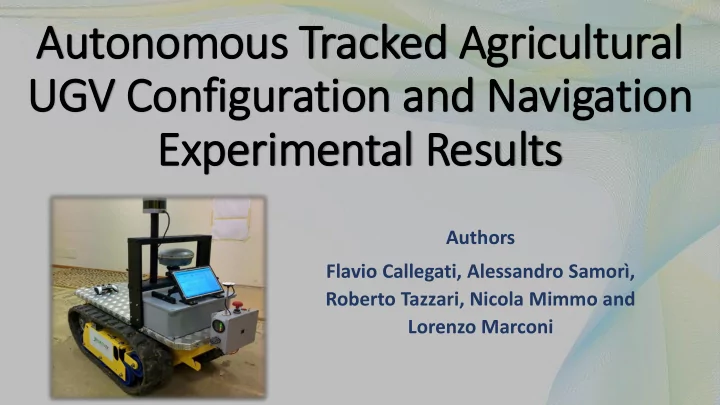

Autonomous Tracked Agricultural UGV Configuration and Navigation Experimental Results Authors Flavio Callegati, Alessandro Samorì, Roberto Tazzari, Nicola Mimmo and Lorenzo Marconi
Precis isio ion Agric iculture Manual workers and Mobile Robots Co-operation • Introduction • Hardware Structure • Software Architecture • Experiment Purposes • Results • Conclusions
Main in Topic ics & & Purposes Perform Farm To achieve Robustness: Tasks Robustness to - Mechanical Structure Uneven Ground Autonomous Navigation • Introduction • To obtain Local Positioning: Hardware Structure Local - Sensor Suite Positioning • Software Architecture - Software Structure • Experiment Purposes • Results • Conclusions Experimental Tests to evaluate performances
Hardware Structure Mechanical Structure Tracked Vehicle PROs • Robustness to uneveness • Higher traction CONs • Skidding effect • Introduction Sensor Suite • Hardware Structure • Software 3D Laser Scanner GPS Receiver Architecture - Local Positioning • - Global Positioning Experiment - Obstacle Detection Purposes • Results • Inertial Measurement Unit Conclusions - Attitude Estimation
Soft ftware Subsystem Running on the onboard computer • Intel NUC mini PC Rover management and control • User interfacing • Sensor reading • Introduction • • Data processing Hardware Structure • Motor references computation • Software HMI Architecture • Experiment Two basic software elements Mission/ System Purposes Commands State • Results • HMI ( High level) • Conclusions CONTROL SYSTEM • Control system ( Low level)
Human Machin ine In Interface Functions Appearence • Commands assignment • Google-like satellite map • Mission monitoring • Buttons and labels • Introduction • Hardware Structure • Software Architecture • Experiment Purposes • Results • Conclusions Bidirectional UDP communication with the Control system
Control l System Implemented in ROS (Robot Operating System) • Executables ( ROS nodes ) HMI HMI Pose estimation (PE) Mission/ System • Sensor reading Commands State • Position and attitude estimation • Introduction Row State Pose • Hardware Estimation Machine Row State Machine (RSM) Control Structure • system User commands interpretation • Software Row • Trajectory computation Architecture Control • Elementary functions management • Experiment Purposes • Speed Ref. Results Row control • Conclusions Motors/ Sensors DRIVERS • Feedback control Sensors • Autonomous navigation
ሶ ሶ ሷ Control l System Kinematic model (Differential Drive) 𝑊 𝝏 : rotation velocity 𝒘 : translation velocity • • Defines the lateral distance Depends on the task • • Choosen as control variable Usually small and constant 𝜕 Estimation of the lines of trees • Introduction • Hardware • Structured environment (Rows) Structure • • Need of the relative position ( lateral distance ) Software Architecture • Experiment Purposes Row navigation control • Results • Conclusions 1 𝑒 𝑆 : lateral distance 𝜕 = 𝑒 𝑆 − 𝑙 𝑒 𝑒 − 𝑒 𝑆 − 𝑙 𝑞 𝑒 − 𝑒 𝑆 𝑤 cos 𝜄
Experim iment Descrip iptio ion 3 1. Recognition of being inside the rows and starting navigation 2 2. Keeping desired lateral • Introduction distance • Hardware Structure • Software Architecture • 3. Detection of the row exit Experiment Purposes 1 and stop navigation. • Results • Conclusions
Result lts • Good communication between the software layers • No errors in the • Introduction • Hardware mission assignment Structure • Software Architecture • Experiment • Control law validated Purposes • Results • Conclusions
Result lts • Good estimation of row lines with Hough ’s algorithm • Estimation of distances • and angles with respect Introduction • Hardware to the rows Structure • Software Architecture • Precision (polar • Experiment Purposes coordinates): • Results Δ d=0.1m • Conclusions Δϑ=2 °
Conclu lusio ions • Software structure is flexible and modular • Estimation of distance and heading localizes rover into rows. • Introduction • Hardware Structure • • Merge this estimation with Software Architecture odometry, IMU and GPS data in • Experiment Purposes order to improve rover • Results localization and robustness • Conclusions
THANK YOU FOR YOUR ATTENTION
Recommend
More recommend